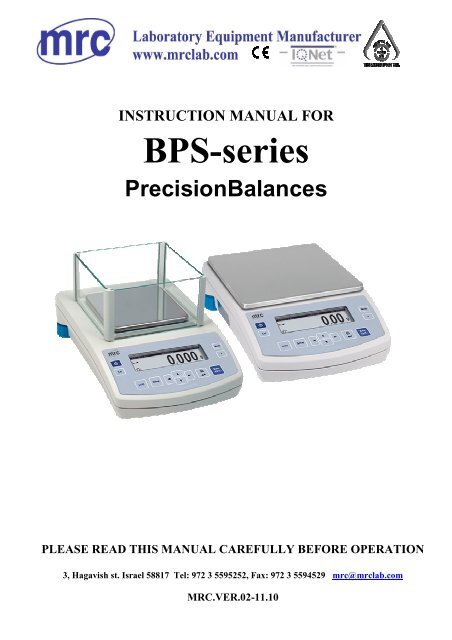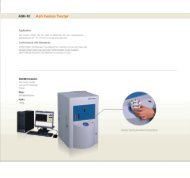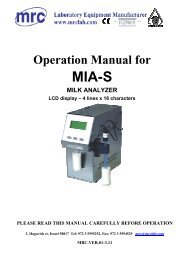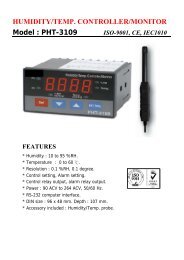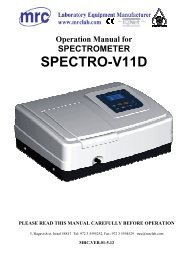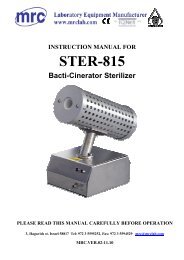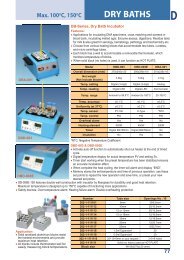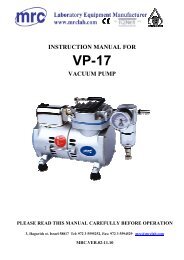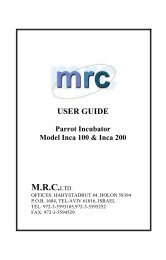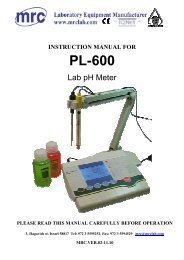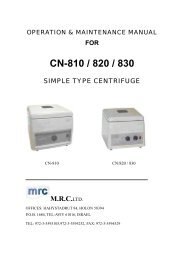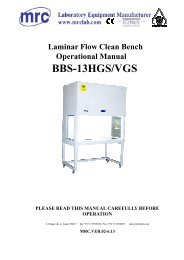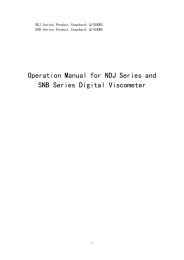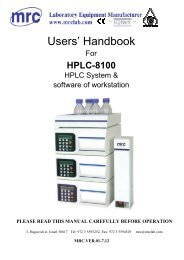Operating Instruction - Precision Balances PS series - MRC
Operating Instruction - Precision Balances PS series - MRC
Operating Instruction - Precision Balances PS series - MRC
You also want an ePaper? Increase the reach of your titles
YUMPU automatically turns print PDFs into web optimized ePapers that Google loves.
INSTRUCTION MANUAL FORB<strong>PS</strong>-<strong>series</strong><strong>Precision</strong><strong>Balances</strong>PLEASE READ THIS MANUAL CAREFULLY BEFORE OPERATION3, Hagavish st. Israel 58817 Tel: 972 3 5595252, Fax: 972 3 5594529 mrc@mrclab.com<strong>MRC</strong>.VER.02-11.10
Contents1. TECHNICAL DATA ............................................................................. 62. BASIC INFORMATION ........................................................................ 82.1. Intended use .......................................................................................... 82.2. Inappropriate use ................................................................................... 82.3. Warranty ................................................................................................ 82.4. Monitoring the metrological parameters of the instrument ..................... 92.5. Data included in this user manual .......................................................... 92.6. Staff training ........................................................................................... 93. TRANSPORT AND STORAGE ........................................................... 93.1. Acceptance check .................................................................................. 93.2. Packaging .............................................................................................. 94. UNPACKING, INSTALLATION AND COMMISSONING .................. 104.1. Installation and operation place ........................................................... 104.2. Unpacking ............................................................................................ 114.3. Positioning ........................................................................................... 124.4. Standard accessories .......................................................................... 124.5. Cleaning .............................................................................................. 124.6. Connection to mains ............................................................................ 124.7. Connection of additional equipment ..................................................... 125. BASIC FUNCTIONS OF THE INSTRUMENT ................................... 136. KEYBOARD ....................................................................................... 147. USER MENU ...................................................................................... 157.1. Moving in user menu ........................................................................... 177.1.1. Return to weighing function ............................................................. 178. WEIGHING ......................................................................................... 178.1. Choice of basic weighing unit .............................................................. 188.2. Choice of weighing unit (temporary) .................................................... 198.3. Setting accessibility of balance operating modes ................................ 208.3.1.8.3.2.Choice of modes quantity accessible for user ................................. 20Setting contents of P6.1 FFun – ALL parameters ........................... 229. MAIN SETTING PARAMETERS ....................................................... 239.1. Setting level of filtering ......................................................................... 249.2. Result confirmation .............................................................................. 259.3. Autozero function ................................................................................. 269.4. Light off the last display digit ................................................................ 2710. ANOTHER PARAMETERS ........................................................... 2810.1. Backlight of weighing result ................................................................. 2810.2. Adjusting brightness of display backlight ............................................. 293
10.3. “Beep” signal – reaction on pressing key ............................................. 3010.4. Printout of all balance parameters through RS 232 port ...................... 3111. BALANCE CALIBRATION ........................................................... 3111.1. Balance with internal calibration .......................................................... 3211.2. Entering calibration menu .................................................................... 3311.3. Calibration test ..................................................................................... 3711.3.1.11.3.2.<strong>Balances</strong> with internal calibration ............................................... 37<strong>Balances</strong> with external calibration .............................................. 3811.4. Manual calibration ................................................................................ 3911.4.1.11.4.2.Internal calibration ...................................................................... 39External calibration ..................................................................... 4011.5. Calibration report printout .................................................................... 4012. SETTING PRINTOUTS FOR GLP PROCEDURES ...................... 4112.1. Setting the contents of printouts for GLP procedures .......................... 4213. BALANCE OPERATING MODES................................................. 4613.1. Counting details of the same mass ...................................................... 4713.2. +/- control referring mass of set standard ............................................ 5013.3. Control of % deviation referring mass of standard ............................... 5313.3.1.13.3.2.Mass of standard determined by its weighing ............................ 53Mass of standard entered to balance memory by user .............. 5413.4. Defining thickness of solids and liquids ............................................... 5513.4.1.13.4.2.Testing thickness solids ............................................................. 56Testing thickness of liquid .......................................................... 5613.5. Summing function ................................................................................ 5714. FUNCTIONS FOR USING RS 232 ................................................ 5914.1. Speed of transmission ......................................................................... 6014.2. Continuous transmission ..................................................................... 6114.2.1.14.2.2.Continuous transmission off in basic interval ............................. 61Continuous transmission of in actual units ................................. 6214.3. Setting type of operating for RS 232 joint ............................................ 6314.4. Designation of data type sent through RS 232 joint ............................. 6414.5. Designation of minimum mass for operating of some functions ........... 6515. COOPERATION WITH PRINTER OR COMPUTER ..................... 6615.1. Schedules of connecting conductors ................................................... 6715.2. Printing data with date and time ........................................................... 6815.3. Cooperation with statistic printout Kafka SQS ..................................... 6815.4. Format of sending data ........................................................................ 6815.4.1.15.4.2.Format of sent data after pressing the PRINT button ................. 69Format of sent data for orders generated from the computer ..... 6916. WEIGHING LOADS UNDER BALANCE ...................................... 7017. LIST OF ORDERS IN RADWAG BALANCES ............................. 714
1. TECHNICAL DATAInternalcalibrationB<strong>PS</strong> 510 /C/2/CTB<strong>PS</strong> 200 /2000/C/2B<strong>PS</strong>110/C/2B<strong>PS</strong>210/C/2B<strong>PS</strong>360/C/2B<strong>PS</strong>600/C/2B<strong>PS</strong>750/C/2B<strong>PS</strong>1000/C/2ExternalcalibrationB<strong>PS</strong> 510 /C/1/CTB<strong>PS</strong> 200 /2000/C/1B<strong>PS</strong> 60/C/1B<strong>PS</strong>110/C/1B<strong>PS</strong>210/C/1B<strong>PS</strong>360/C/1B<strong>PS</strong>510/C/1B<strong>PS</strong>750/C/1B<strong>PS</strong>1000/C/1Max capacityTare rangeMin capacityReadabilityRepeatabilityLinearityWorkingtemperaturePowerDriftsensitivityPan size510g /2550ct-510g /-2550ct0,02g /0,1ct0,001g /0,005ct0,001g /0,005ct±0,001g/0,005ct200 /2000g60g 110g 210g 360g 510g 600g 750g 1000g-2000g -60g -110g -210g -360g -510g -600g -750g -1000g20mg1/10mg20 mg1 mg1/10mg 1 mg 1,5 mg±2 /10mg± 2 mg ± 3 mg+15 °C ÷ +30 °CZasilacz 230V 50Hz AC /11 V AC2 ppm/°C w temp. +18°C - +30°C128 x 128mmDimensions:6
InternalcalibrationB<strong>PS</strong>2100/C/2/CTB<strong>PS</strong> 1200/C/2B<strong>PS</strong> 2100/C/2B<strong>PS</strong> 3500/C/2B<strong>PS</strong> 4500/C/2B<strong>PS</strong> 6000/C/2ExternalcalibrationB<strong>PS</strong>2100/C/1/CTB<strong>PS</strong> 600/C/1B<strong>PS</strong> 1200/C/1B<strong>PS</strong> 2100/C/1B<strong>PS</strong> 3500/C/1B<strong>PS</strong> 4500/C/1B<strong>PS</strong> 6000/C/1Max capacityTare rangeMin capacityReadabilityRepeatabilityLinearityWorkingtemperaturePowerDrift sensitivityPan size2100 g /10500 ct-2100 g /-10500 ct0,5 g /2,5 ct0,01 g /0,05 ct0,01 g /0,05 ct± 0,01 g /0,05 ct600 g 1200g 2100 g 3500 g 4500 g 6000 g-600 g -1200g -2100 g -3500 g -4500 g -6000 g500 mg10 mg10 mg 15 mg± 20 mg+15 °C ÷ +30 °CZasilacz 230V 50Hz AC /11 V AC2 ppm/°C w temp. +18°C - +30°C195 x 195mmDimensions of balance:7
2. BASIC INFORMATION2.1. Intended useBalance you have acquired serves to determine the weighing value of a load inlaboratory environment. It is intended for application as a non-automaticweighing instrument only, i.e. the material to be weighed is manually andcarefully placed in the center of the weighing pan. Weighing result should beread only after stable reading has been obtained.2.2. Inappropriate useDo not use the balance as a dynamic weighing instrument. Even if smallquantities of weighed material are added or removed from the weighing pan ofthe instrument, the reading should be taken only after stabilization of the result.Do not place any magnetic materials on the weighing pan, as this can causedamage of the measuring system of the instrument.. Be sure to avoid impactshock and overloading the balance in excess of the prescribed maximum loadrating, minus any possible tare weight that has been applied. Never use thebalance in an environment endangered by an explosion. This balance has notbeen adjusted for operation in explosive areas. There must not be anymodification made to the balance.2.3. WarrantyWarranty is not valid at the following:• Non-observation of the guidelines in the user manual,• Use of balance other than specified in this manual,• Alternation to or opening of the device,• Mechanical damage and damage caused by media, natural water,and tear,• Inappropriate erection or electric installation,• Overloading of the measuring instrument.8
2.4. Monitoring the metrological parameters of the instrumentMetrological features of the balance should be tested by the user within regularintervals of time, within scope of quality assurance.2.5. Data included in this user manualPlease read the user manual carefully before erecting and commissioning,even if the user has is experienced with this kind of weighing instruments.2.6. Staff trainingThis balance may only be operated and looked after by trained member ofstaff.3. TRANSPORT AND STORAGE3.1. Acceptance checkPlease check the packaging immediately upon delivery and the device duringunpacking for any visible signs of external damage.3.2. PackagingPlease retain all parts of the original packaging in case it should be necessaryto transport or return items at any time. Only the original packaging should beused for return consignments. Before dispatch, disconnect all attached cablesand loose/movable parts (weighing pan, protecting shields, etc). Please placeany elements of the balance in its original packing. Please protect the balanceand its parts against any damage while in transport.9
4. UNPACKING, INSTALLATION AND COMMISSONING4.1. Installation and operation place• Balance should be stored and used in locations free of vibrations andshakes, free of wind and dust.• Air temperature should not exceed range between:+10 o C ÷ +45 o C• Humidity of air should not exceed 80% (not condensing).• When operating the balance, room temperature should not change morethan 0,5 ° C within one hour,• The balance should be placed on a stable surface not affected by vibrationsand distant from heat sources.• Please take special safety measures when weighing magnetic loads, as partof this balance is a strong magnet. If there is a necessity to performmeasurement of such load, please use option of under hook weighing, whichremoves the load from area influenced by the magnet. For installation placeof under hook device, please look at the bottom casing of the balance,.• Avoid static charging of items to be weighed, or weighing container. In caseof static discharges may occur, please ground the device. Grounding bolt isplaced at the back side of the balance’s casing.10
4.2. UnpackingCarefully remove the balance from its packaging, remove the plastic and foilwrapping and gently. Install the weighing pan, and other elements according tobelow schema:- Take of the tape whichsecures the static voltagespring on one of the rubbersupporters (2),- Put on the weighing pan (1)on the rubber supporters (3),- After putting on all of aboveparts, please check if theweighing pan is firmly locatedon the rubber supporters.- Take of the tape whichsecures the static voltagespring on one of the rubbersupporters (3),- Put on the weighing pan (2)on the rubber supporters,- Put on the glass draughtshield (1), placed on thesurface of upper casing of thebalance,- After putting on all of aboveparts, please check if theweighing pan is firmly locatedon the rubber supporters.11
4.3. PositioningBefore switching on the balance, please level the devicewith two adjusting feet situated at the back of the casing.Please level the balance so that the air bubble of the levelis placed centrally.4.4. Standard accessories• Balance.• Weighing pan and protecting elements.• Power adapter.• User manual.4.5. CleaningBalance should be cleaned with damp cloth. In order to clean the weighing panof the balance, please remove it from the weighing chamber. Cleaning of thepan when installed may cause damage of the measuring system of thebalance.4.6. Connection to mainsBalance can be connected to mains only with a power adapter offered asstandard accessory to the balance. Nominal power supply of the power adapter(specified on the data plate of the power adapter) should be compatible to thepower from mains. Please plug the adapter the socket at the back of thebalance, the display with light on and show sequence of digits – display test),after which balance will display 0.0000g. if indication is different from zero,please press ESC/TARA button.4.7. Connection of additional equipmentThe balance must be disconnected from the mains before connecting ordisconnecting additional equipment (printer, PC) to or from the data interface.Use only accessories and peripheral equipment recommended by themanufacturer with your balance. These have been ideally coordinated to yourbalance.12
5. BASIC FUNCTIONS OF THE INSTRUMENTElectronic balance is appropriate for precise measurements mass in laboratoryconditions with possibility of setting to zero in all measure range. Balancecalibration is done by CAL on balance keyboard.Functions for weighing units (press Units key)- select default units of weighing ,- Weighing in grams,- Weighing in [mg],- Weighing in [ct],- Weighing in units from beyond SI (only: [oz], [ozt], [dwt], [t], [mom], [gn],Access to these units is blocked from factory menu level, Functions for calibration and weighing modes- Counting pieces < PIECES>,- Control +/- ,- Control of deviations % according to standard mass ,,- Thickness of liquids or solids , Choice of criteria of stable result depending on usage conditions- Turn off/on system of autozero ,- Average result of weighing ,- Back light function,- Beep signal , Function for using RS 232- Choose speed of transmission,- Define sent data as: stable / not stable,- Continuous work,- automatic work for RS 232.Moreover balance can be used to weigh hang loads, print report of calibration,check deviation of calibration and print reports of testing thickness of liquids andsolids.13
www.mrclab.com
7. USER MENUMenu is divided into 7 basic groups. Each group has individual name starting withcapital letter P. Names of groups and their contents is shown below.P1 CAL [Calibration]P1.1 iCAL | [internal calibration]P1.2 ECAL | [external calibration]P1.3 tCAL | [temperature calibration]P1.4 ACAL | both/nonE/tenno/tinnE [automatic calibration]P1.5 CALt | 1 h ÷ 12h [time of automatic calibration]P1.6 CALr | YES/no [report from calibration]P2 GLP [Good Laboratory Practice ]P2.1 USr | _ [name of user]P2.2 PrJ | _ [name of project]P2.3 Ptin | YES/no [printout of measurement time]P2.4 PdAt | YES/no [printout of measurement date]P2.5 PUSr | YES/no [printout of user name]P2.6 PPrJ | YES/no [printout of project name]P2.7 PId | YES/no [printout of factory number of balance]P2.8 PFr | YES/no [printout of frames]P3 rEAd [Main user parameters]P3.1 AuE | Stand/Slouu/FASt [filtering level]P3.2 ConF | FASt_rEL/Fast/rEL [confirmation of result]P3.3 Auto | On/OFF [autozero]P3.4 Ldi9 | ALuuAYS/never/uu_StAb [light off the last digit]15
P4 Print [Data transmission – RS 232]P4.1 bAud | 2400/4800/9600/19200 [speed of transmission]P4.2 CntA | YES/no [continuous printout in basic unit]P4.3 Cntb | YES/no [continuous printout in currentlyused unit]P4.4 rEPL | YES/no [manual or automatic operating]P4.5 <strong>PS</strong>tb | YES/no [result printout: stable or unstable]P4.6 Lo | 000.0000 [min mass for automatic operating]P5 Unit [Mass units]P5.1 StUn | g/mg/ct/oz/ozt/dwt/t/mom/G [basic mass unit – e.g. gram]P5.2 mg | YES/no [mg - milligram]P5.3 Ct | YES/no [ct – carat]P5.4 oZ | YES/no [oz – ounce]P5.5 oZt | YES/no [ozt – troy ounce]P5.6 dwt | YES/no [dwt – pennyweight]P5.7 t | YES/no [t – tael]P5.8 nno | YES/no [mom - momme]P5.9 Gr | YES/no [gr – grain]P6 Func [Functions]P6.1 FFun | [choice of balance function]P6.2 PcS | YES/no [counting pieces]P6.3 HiLo | YES/no [check weighing]P6.4 PrcA | YES/no [% deviation with reference toweighed standard mass]P6.5 Prcb | YES/no [% deviation with reference to declaredstandard mass]P6.6 d_Co | YES/no [density determination of solids]P6.7 d_Li | YES/no [density determination of liquids]P7 othEr [Other functions]P7.1 bL | On/Aut/OFF [display backlight]P7.2 bEEP | On/OFF [keys sound]P7.3 PrnS | [printout of balance parameters]16
7.1. Moving in user menuUser moves in menu using balance keyboard (see point no 6)7.1.1. Return to weighing functionIntroduced changes in balance memory will be saved for good afterreturn to weighing with procedure of saving changes. Press severaltimes Esc key until display indicates message SAvE?.When display indicates question press if necessary: PRINT/ENTER –confirmation of changes or ESC – resignation from introduced changes.After pressing appropriate key, balance will go back to weighing.8. WEIGHINGBefore weighing or if the conditions of work changes (e.g. if temperature ofsurrounding is higher then 3 o C) balance should be calibrated.• Balance should be loaded few times by mass close to max capacity beforetaking measurements,• Check if not load balance shows „precise zero” - if measurement isstable - order , if not press key →0/T←,• by means of Units key set measure unit : [g], [mg], [ct], and if they areaccessible in factory menu [oz], [ozt], [dwt], [t], [mom], [gn],• put load on balance and read result on display ,• indication can be setting to zero many times by pressing key Esc/TARE(summary of mass loads record to balance memory cannot be bigger then itsmax capacity).17
www.mrclab.com
After choosing basic unit press ENTER/PRINT key. Chosen unit will stoppulsing.Possibilities of choice:• For EC verified balances, user can choose following units: [g], [mg], [ct]• For non-verified balances, user can choose following units: [g], [ct], [mg],[oz], [ozt], [dwt], [t], [mom], [gn].Go back to weighing mode with procedure of saving changes(see point - 7.1.2. – return to weighing).ATTENTION:Balance after switching on will start with set basic unit.8.2. Choice of weighing unit (temporary)Function enables choice of unit with which mass on the pan will be indicated.Unit will be valid until change of unit or switching on and off the balance. Eachpressing the Units key, causes change of measuring unit.Possibilities of choice:• For EC verified balances, user can choose following units: [g], [mg], [ct]• For non-verified balances, user can choose following units: [g], [ct], [mg],[oz], [ozt], [dwt], [t], [mom], [gn].19
8.3. Setting accessibility of balance operating modesIn this group of parameters user declares functions which are to be accessiblefor user after pressing SETUP key.Enter group P6 Func.8.3.1. Choice of modes quantity accessible for userFunction enables user to set if after pressing RIGHT ARROW key alloperating modes will be accessible (ALL) or only one from the list chosenand used by operator, or all functions unavailable (OFF).20
After choosing setting press ENTER/PRINT key. Balance will go back todisplaying name ofsubmenu.P6.1 FFun. If function other than ALL is chosen,procedure of returning to weighing differs from remaining ones. If e.g. functionPcS is chosen (procedure according to 13.1 point), to return to weighing:21
Press key Esc/TARA, balance will return to weighing.8.3.2. Setting contents of P6.1 FFun – ALL parametersFunction enables switching off modes not used by operator. This causesfaster access to used modes.22
OFF – inaccessible modeOn – accessible mode.Return to weighing(see - 7.1.2. – return to weighing).9. MAIN SETTING PARAMETERSUser can adjust balance to external conditions (filter range) or own needs (autozeroworking, memory of tare value). These parameters are in group .These functions will help user to adjust balance to external conditions in whichbalance operates.23
9.1. Setting level of filteringProcedure:- using NAVIGATION BAR choose value of filter which is needed1 - filtr FASt – (fast)2 - filtr StAnd – (standard)3 - filtr Slouu – (slow).Return to weighing(see - 7.1.2. – return to weighing).ATTENTION:The higher filtering level the longer time of weighing.24
9.2. Result confirmationBecause of various environmental conditions it is advisable to adjust thebalance by selecting method of result confirmation as: FAST_rEL, Fast or rEL.Depending on selected option, time of weighing will be shorter or longer.Fast_rELFastrEL- fast + release- fast- release.Return to weighing(see - 7.1.2. – return to weighing).25
9.3. Autozero functionIn order to ensure precise indication of balance, „AUTOZERO” function wasintroduced. The application of this function is automatic control and correctionof zero indication of balance.When function is active comparison of results takes place at declared timeintervals e.g. every 1 s, only when the pan is unloaded and results are close tozero.If results vary by value smaller than declared AUTOZERO range e.g. onedivision, balance will zero automatically and stable result marker– andzero indication – will be displayed.When AUTOZERO function is on each result starts from precise zero. Howeverthere are some cases where this function can be disturbance atmeasurements. Such instance is very slow placing of load on the pan (e.g. loadpouring) in such case correction system of zero indication can also correctindication of real mass of load.Procedure:AUTOZEROAUTOZEROOFF – autozero offOn - autozero on.Return to weighing(see - 7.1.2. – return to weighing).26
9.4. Light off the last display digitFunction enables light off the last digit on the display.ALuuAYSnEuEruu_StAb- always- never- when is stable.Return to weighing(see - 7.1.2. – return to weighing).27
10. ANOTHER PARAMETERSUser can set parameters which have influence on work with balance. Theseparameters are contained in P5 othEr e.g. backlight and „beep” signal.Enter to P5 Others group of submenu according to point 6.1.10.1. Backlight of weighing resultbl OFF – backlight offbl On – backlight onbl Aut – If result of weighing doesn’t change for 10 seconds,backlight will turn off automatically.Return to weighing(see - 7.1.2. – return to weighing).ATTENTION:If result of weighing doesn’t change for 10 seconds, backlight will turn offautomatically. Backlight is turned on when indication on display changes.28
10.2. Adjusting brightness of display backlight100 - maximum brightness of display backlight20 - minimum brightness of display backlightno - backlight off29
10.3. “Beep” signal – reaction on pressing keybEEPbEEPOFF – signal of pressing key offOn - signal of pressing key on.Return to weighing(see - 7.1.2. – return to weighing).30
10.4. Printout of all balance parameters through RS 232 portAfter pressing F key, balance parameters will be send through RS 232 port.Return to weighing(see - 7.1.2. – return to weighing).11. BALANCE CALIBRATIONAs the acceleration value due to gravity is not the same at every location on earth,each balance must be coordinated – in compliance with the underlying physicalweighing principle – to the existing acceleration due to gravity at its place of location(only if the balance has not already been adjusted to the location in the factory).This adjustment process must be carried out for the location in the factory). Thisadjustment process must be carried out for the commissioning, after each changeof location as well as in case of fluctuating environment temperature. It is alsorecommend to adjust the balance periodically during weighing operation in order toobtain exact measured values.To ensure high precision of weighing corrective factor in relation to standard massmust be noted in the balance memory periodically – it is the balance calibration.Calibration should be performed:- Before the weighing,- When long breaks are between following measure <strong>series</strong>- When temperature inside the balance changes more than: 3° C.Kind of calibration:- Internal automatic calibration* started if temperature changes* started if the time changes31
- Manual internal calibration* initiated from the balance keyboard- Calibration made with external weight* with declared mass which cannot be modified.In verified balances (with internal calibration) only automatic internal calibration andmanual internal calibration is accessible, however in verified balances with externalcalibration, the calibration process is not accessible.Perform the calibration when there is no load on the pan!In case when there is load on the pan, display will indicate unload. It iscomment of unloading the pan. Calibration process can be stopped if it’snecessary. Press then Esc/TARA key.11.1. Balance with internal calibrationProcess of calibration can be started automatically or manually.Manual way of operation is to press CAL key. System of automatic calibrationwill automatically perform calibration informing user about successive stages.Cycle of automatic calibration proceeds as follows:- balance software detects necessity of calibration and signalizes it by marker ofCelsius degree or by black marker- from this moment time of 5 minutes is counted in which weighings can beperformed- when this time elapses display indicates CAL_30 message and starts countdown 30..29..28 do 0 (indicated value is the counter)- user has 30 seconds to make a decision:• if calibration is to be performed, does not take any actions• if one wants to finish measurements presses ESC/TARE key, after itspressing balance returns to weighing showing previous result of weighing(possibility of finishing <strong>series</strong> of measurements) in 5 minutes balance willindicate CAL_30 message again32
- process of calibration can be postponed frequently, but fact that long postponingof calibration can be cause of bigger error during weighing should be noticed.These errors are effect of changes of temperatures and as consequencechanges of balance sensitivity.Automatic system includes 3 possibilities:- calibration with regard to changes of temperaturebalance is provided with precise system of controlling temperaturechanges, temperature of calibration is registered every time, next is startedif temperature of surrounding changes 3 o C- calibration with regard to passage of timeuser can declare 4 spaces of time that makes criterion for calibration,following option are accessible: calibration every 1 - 12 hours.11.2. Entering calibration menuP1 CALP1.1 iCAL |P1.2 uCAL |P1.3 tCAL |P1.4 ACAL | bothP1.5 CALt | 1 hP1.6 CALr | YES33
P1.1 iCAL – Internal calibrationstart of internal calibration process, process is completely automatic withoutinterference of balance operator, if pan is loaded display will indicate messageabout necessity of removing the load.or CAL buttonP1.2 ECAL – External calibrationcalibration with external weight, which value is saved in factory menu ofbalance, function unavailable in verified balances.balances with internal calibrationbalances with external calibrationP1.3 tCAL - Test of calibrationcomparison of internal calibration mass with its value saved in balance memory.balances with internal calibrationbalances with external calibrationP1.4 ACAL – Automatic calibration (balances with internal calibration)determination of factor, which should decide about starting the automatic internalcalibrationnonE – none of factors will cause start of calibrationtEmP – calibration with regard to change of temperaturetimE – calibration with regard to time set in P1.5 CALtboth – calibration with regard to time and temperature.34
P1.5 CALt – Time of automatic calibration (balances with internalcalibration)determining the time, after which automatic calibration will start.P1.6 CALr – printout from calibration reportSetting printout of report after finished calibrationno – printout of report offYES – printout of report on.balances with internal calibrationbalances with external calibration36
11.3. Calibration test11.3.1. <strong>Balances</strong> with internal calibrationInternal calibration mass is compared to its value in the balance memory.This process is automatic. Its result is shown on the display. Processproceeds automatically and display indicates its result (if balance isconnected to computer or to printer through RS 232 joint, printout ofcalibration test will take place). Press ESC/TARA key to return to previousscreen.Procedure:Return to weighingThe changes are recorded when the balance returns to weighingmode with the recording the changes. Press the ESC many times.Following question appears on the display.Select one of the options : ENTER – record / ESC – cancel(Return to weighing 7.1.2. Return to weighing).37
11.3.2. <strong>Balances</strong> with external calibrationIt consists in comparison of mass of standard with mass previously savedin balance memory during the calibration. Process proceeds automaticallyand display indicates its result (if balance is connected to computer or toprinter through RS 232 joint, printout of calibration test will take place).Press ESC/TARA key to return to previous screen.Procedure:Return to weighing(see - 7.1.2. – return to weighing).38
11.4. Manual calibration11.4.1. Internal calibration• Press F key three times• The balance performs the calibration automatically. During this calibrationdo not load the pan.• After this process the balance records results of the calibration in thememory and returns to weighing mode.ATTENTION:- Pressing the ESC key stops the calibration process- If during the calibration load is on the pan display show order about error.The calibration process is stopped. After take load off the calibrationprocess is finished.39
11.4.2. External calibrationThe external calibration should be performed with external mass class F 2• Start external calibration processbalances with external calibration• Order to load off the pan appears on the display (no load on the pan). Afteryesing load off the pan press the ENTER key.• The balance determines mass of empty pan• Put load and press the ENTER• After the calibration the balance returns to submenu P1.2 uCAL• Return to weighing – as in the point 5.1.2.If balance is verified user does not have the possibility to perform externalcalibration process.11.5. Calibration report printoutAfter calibration user can receive the calibration report. The report can beprinted on connected printer and sent to computer or recorded in file.P1.6 CALr: no – report is not printedP1.6 CALr: YES – report is printedIf the parameter has the value YES, the report is generated and sentautomatically.40
A content of report depends on setting in submenu GLP. All options with YESattribute are printed.P2 GLPP2.1 uSr |P2.2 PrJ |P2.3 Ptin | YESP2.4 PdAt | YESP2.5 PuS | YESP2.6 PPrJ | YESP2.7 PId | YESP2.8 PFrn | YESApart from information settled in menu group the report contains: differencebetween calibration mass remembered by balance after last calibration andcalibration mass determined during actual calibration and other information.12. SETTING PRINTOUTS FOR GLP PROCEDURESP2 GLP is group of the parameters which declares factors on the calibrationprintout.P2 GLPP2.1 uSr |P2.2 PrJ |P2.3 Ptin | YESP2.4 PdAt | YESP2.5 PuS | YESP2.6 PPrJ | YESP2.7 PId | YESP2.8 PFrn | YES41
For fields:- user (max 8 alphanumerical signs)- design (max 8 alphanumerical signs)introduce names by the balance keyboard.For the rest select:- no (do not print during report)- yes (print during report)12.1. Setting the contents of printouts for GLP proceduresP2 GLP group of parameters enabling to declare variables, which will appearon calibration printout and printout from measurement.P2 GLPP2.1 USr |P2.2 PrJ |P2.3 Ptin | YESP2.4 PdAt | YESP2.5 PUSr | YESP2.6 PPrJ | YESP2.7 PId | YESP2.8 PFr | YES42
• P2.1 USrOption enabling to introduce name of user who operates the scale. User haspossibility to introduce the name consisting of max 8 alphanumeric characters.Introduction the name is possible by the means of scale keyboard withNAVIGATION BAR and ENTER key.43
Available characters and their equivalents displayed by scale are shown on thedrawing below:Exemplary user name introduced to scale with capital letters:OP1_WILK (operator 1 WILK)Exemplary user name introduced to scale with small letters:op1_wilk (operator 1 wilk)44
• P2.2 PrJOption enabling to introduce the Project name (e.g. associated with specificweighing type).Exemplary project name introduced to scale with capital letters:PRRADWAGExemplary project name introduced to scale with small letters:prradwag• P2.3 PtinOption enabling to print time of performed measurement.• P2.4 PdAtOption enabling to print data of performed measurement.• P2.5 PUSrOption enabling to print user name.• P2.6 PPrJOption enabling to print project name.• P2.7 PIdOption enabling to print factory number of scale.• P2.8 PFrOption enabling to print frames on printout.Parameters described above, choose the values:noYES- not to print during report- to print during report.Return to weighing(see - 7.1.2. – return to weighing).45
13. BALANCE OPERATING MODES- Weighing mode (basic)- Counting pieces- +/- control referring mass of set standard- Control of % deviation referring mass of standard- Definition thickness of solids and liquids.Press MODE key:After pressing MODE key, name of first available function will be indicated. Eachnext pressing DOWN or TOP ARROW key causes displaying name of next46
available functions, way of setting the functions is described in further part of thismanual.13.1. Counting details of the same massBalance in standard execution is equipped with option of counting small piecesof the same mass. Counting pieces doesn’t operate with other balancefunctions.To use this option:• enter to PIECE function.• press TOP or DOWN ARROW key to start setting quantity of sample, youhave at choice few options47
• if you want to choose one them e.g. 20pcs press ENTER/PRINT andproceed as shown on picture48
−If option FrEE was chosen, you must enter quantity of sample, which will serveto determine mass of single detail−Pressing RIGHT ARROW key chooses digit which will be changed−Pressing TOP ARROW changes value of digit• Confirm entered value by pressing ENTER/PRINT key• Display will indicate LoAd message – place on the pan as many details asentered during option• Press ENTER/PRINT key – balance will indicate quantity of sample (PCSsymbol is active)• add remaining details, display will indicate their quantity.Return to weighing(see - 7.1.2. – return to weighing).49
ATTENTION:If user presses ENTER key when details are not placed on the pan, message Er8outr will be indicated for few second and balance will automatically return toweighing.13.2. +/- control referring mass of set standardProcedure of operating:Enter to function50
13.3. Control of % deviation referring mass of standardBalance software enables control of deviation (in %) of weighed loads massreferring mass of standard. Mass of standard can be determined by itsweighing (PERC A function) or entered to balance memory by user (PERC Bfunction).13.3.1. Mass of standard determined by its weighingProcedure:• Enter to function• place on the pan load which mass will be accepted as standard• press ENTER/PRINT to confirm this operating mode• after few seconds indication 100,00% will be displayed.53
From this moment display will not indicate mass of weighed load but deviation ofload mass placed on the pan referring mass of standard (in %).13.3.2. Mass of standard entered to balance memory by userProcedure:• Enter to function.• Display will show indication as above• Using keys choice of set digit and choice of digit valueset value of mass of standard, enter it to balance memory using PRINTkey – display will indicate: 0,00%54
From this moment display will not indicate mass of weighed load but deviationof load mass placed on the pan referring mass of standard (in %).Return to weighing(see - 7.1.2. – return to weighing).13.4. Defining thickness of solids and liquidsThere is equipment to defining thickness of solids and liquids in additionalequipment. For user request <strong>MRC</strong> service can render special software todetermine thickness by balance accessible.1. beaker support2. frame of balance3. plunger4. beaker5. thermometer clench6. thermometer7. plunger string8. plunger hanger9. upper balance10. balance string11. down pan12. frame55
13.4.1. Testing thickness solidsThickness of solids can be tested in one of 3 liquids:• H2O (distilled water),• C2H5OH (spirit 100% +/- 0.1% in temp. 20 0 C),• AnotHEr (another liquid with known thickness)Give temperature of liquid for distilled water and spirit. For liquid withknown thickness value is written on keyboard.To test thickness weigh sample on upper pan and weigh the same samplein liquid (on lower pan). Result is represented on display automaticallyafter replacing sample in liquid.13.4.2. Testing thickness of liquidBasic element for measuring thickness of liquid is glass plunger. It hasprecise capacity shown on hook.Before final measurements this value should be introduced to balancememory. To test thickness of liquid weigh glass plunger on upper pan andin tested liquid. Result of testing is shown on display automatically afterintroducing mass of plunger.56
13.5. Summing functionIn sum procedure following components are added in order to make mixture. Afteradding following component composition of the mixture is presented on the display.During sum procedure masses of the components are sent to joint RS 232 (printouton the printer or sending to computer application).Procedure:• Enter to function.57
Return to weighing(see - 7.1.2. – return to weighing).14. FUNCTIONS FOR USING RS 232- Choose speed of transmission- Define sent data as: stable / not stable- Continuous work- Setting data as additional element of parameter in printouts- Turn on/off sign of last digit in printout- automatic operating for RS 232.59
14.1. Speed of transmissionMethod of setting speed of transmission:−choose required speed of transmission- 2400 bit/s- 4800 bit/s- 9600 bit/s- 19200 bit/s.Return to weighing(see - 7.1.2. – return to weighing).60
14.2. Continuous transmission14.2.1. Continuous transmission off in basic intervalProcedure:CntA no – continuous transmission offCntAYES - continuous transmission on.Return to weighing(see - 7.1.2. – return to weighing).61
14.2.2. Continuous transmission of in actual unitsProcedure:Cntb no – continuous transmission offCntbYES - continuous transmission on.Return to weighing(see - 7.1.2. – return to weighing).62
14.3. Setting type of operating for RS 232 jointProcedure:rEPLrEPLno – manual operating / after pressing PRINT keyYES - automatic operating / after stabilization of weighingresult.Return to weighing(see - 7.1.2. – return to weighing).Automatic operating takes place according to following scheme:• press TARE key to zero the balance (display will indicate marker ofstable measurement and marker of zero)• place the load, balance will send through the RS232 first stablemeasurement• remove load from the pan,• next measurement will be possible when weighing result +/- 50reading units referring to zero (by next measurement zero stat is notrequired).63
14.4. Designation of data type sent through RS 232 joint(only for non-verified balances)Procedure:<strong>PS</strong>tb no – sending stable or temporary result of weighing<strong>PS</strong>tb YES – sending stable result of weighing.Return to weighing(see - 7.1.2. – return to weighing).64
14.5. Designation of minimum mass for operating of some functionsSoftware enables setting operating of function automatic operating.- for automatic operating result will not be sent to computer or printer untilindication of mass goes below set Lo net valueProcedure:Return to weighing(see - 7.1.2. – return to weighing).65
15. COOPERATION WITH PRINTER OR COMPUTEREvery pressing of key < PRINT > sends signal of current display state withmeasuring units to computer or printer. Balance has factory setting speed oftransmission 4800 bit/s. If external mechanism (printer, computer) require differentsetting of speed of transmission, change factory setting on speed in menu(parameter bod)Transmission parameters programmed in balance:- Speed of transmission - 2400 – 19200 bit / s- Data bits - 8- Stop bit - 1- Parity control - none.Sending weighing results to computer can take place:- manually - after pressing PRINT key- continuously – after function activating or sending steering commend- automatically – when result is stable (if REPL YES and beforeplacing weighed load balance indicated value below set Lo value)- on demand computer – see List of messagesValue indicated by display can be sent through connection in <strong>series</strong> as:- stable – start of sending the information will take place when weighingresult is stable- unstable – state of display is sent to external device when pressingPRINT key, and on printout such state is marked with beforeweighing result.66
15.1. Schedules of connecting conductorsWEIGHTCOMPUTER2 (RxD) 3 (TxD)3 (TxD) 2 (RxD)4 (DTR) 6 (DSR)5 (GND) 5 (GND)6 (DSR) 6 (DTR)7 (RTS) 8 (CTS)8 (CTS) 7 (RTS)67
15.2. Printing data with date and timeEvery printout of weighing can be printed with date and time of measurement.It’s possible if balance is connected to printer Kafka 1/Z or Kafka SQ S.After connecting balance and printer set in balance menu parameters of P2GLP group:PdAt on value YESPtin on value YES15.3. Cooperation with statistic printout Kafka SQSAfter connecting balance to printer KAFKA SQ S statistic of measurement ispossible to do. Example of printout with statistics from <strong>series</strong> of measurement:1 9:02:15 + 7.0016 g2 9:02:39 + 5.0152 g3 9:02:58 + 12.0171 g4 9:03:15 + 9.9937 g5 9:03:34 + 12.0169 g6 9:03:48 + 22.0111 gData 13.09.2001 Godz. 9:04n 6 batch quantitysum x 68.0556 g summary of mass of samplesx 11.34260 g average values 5.92328 g standard deviationsrel 52.22 % factor of variancymin 5.0152 g min valuemax 22.0111 g max valueR 16.9959 g difference max – min15.4. Format of sending dataResult of weighing can be sent from balance to external device after pressingthe PRINT button on the balance or after sending order from the computer.68
15.4.1. Format of sent data after pressing the PRINT buttonDepending on setting of P4.5 <strong>PS</strong>tb parameter only stable measurement ormass of instantaneous mass will be sent.For verified balance printout of temporary measurements will be blockedfor instantaneous measurements.Format of printout1 2 3 4 - 12 13 14 - 16 17 18stabilitymarkerspacemarkmassspaceunitCRLFstability marker – [space] if stable[?] if unstable[^] if there is an error of exceeding the range on +[v] if there is an error of exceeding the range on -Mark– [space] for positive values or [-] for negative valuesmass– 9 marks alignment to the rightunits– 3 marks alignment to the left15.4.2. Format of sent data for orders generated from the computerBalance after receiving the command answers first:XX_A CR LF – commend understood, realization startedXX_I CR LF – commend understood, but unavailable at the momentXX _ ^ CR LF – commend understood, but max range is exceededXX _ v CR LF – commend understood, but min range is exceededXX _ E CR LF – error occurred while command realization – exceeded time limitwhile waiting for stable result (time limit is characteristicparameter of balance)XX– name of commandAnd afterwards69
1 - 3 4 5 6 7 8 - 16 17 18 - 20 21 22CommandspacestabilitymarkerspacemarkmassspaceunitCRLFCommand – 1 ÷ 3 marksstability marker – [space] if stable[?] if unstable[^] if there is an error of exceeding the range on +[v] if there is an error of exceeding the range on -mark– [space] for positive values or [-] for negative valuesmass– 9 marks alignment to the rightunit– 3 marks alignment to the left16. WEIGHING LOADS UNDER BALANCEIn standard analytical and precision balances can weigh load on suspension.To use this function:• Remove plastic plug in basic of balance• There is suspension in the basic of balance. It’s installed for good.• Install hook to hang load (hook isn’t standard equipment for balance), weighload on hook.Attention:• Suspension cannot be turned around, move or manipulate. Mechanism ofbalance can be damaged this way.• Mass all additional elements as balance, string should be settled to zeroby pressing key Esc/TARE.70
17. LIST OF ORDERS IN <strong>MRC</strong> BALANCESFunctionFormatFunctionFormatFunctionFormatFunctionFormatFunctionFormatFunctionFormatFunctionFormatFunctionFormatFunctionCommandFunctionCommandTARAT CR LF (setting to tare)ZEROZ CR LF (setting to zero)PRINTSI CR LF (sending results when stab)PRINTS CR LF (sending results now)CONSTANCE WORK - equivalent for key conA onC 1 CR LF (start continuous transmission off in basic interval)MANUAL WORK - equivalent for order conA OFFC 0 CR LF (To change work mode on manual printout)CONSTANCE WORK - equivalent for key conb onCU 1 CR LF (start continuous transmission off in actual interval)MANUAL WORK - equivalent for order conb OFFCU 0 CR LF (To change work mode on manual printout)SEND THE RESULT IN ACTUAL INTERVALSU CR LF (result in actual unit is sent from the balance afterstability)SEND RESULT IN ACTUAL INTERVAL IMMEDIATELY (result inactual unit sending results now)SUI CR LFIf command which is not included in the register or is an error and ends with CR LFis sent to the balance the balance returns command E S CR LF.71
18. ERROR MESSAGESEr1 Hi - wrong initial mass or calibrationEr2 nuLL - values from A.D converter out of the normal range - under rangeEr3 FuL1 - values from A.D converter out of the normal range - over rangeEr4 FuL2 - over rangeEr5 rout - value out of range for performed function e.g value > +/- 2% from initialmass for zeroing,e.g. value


